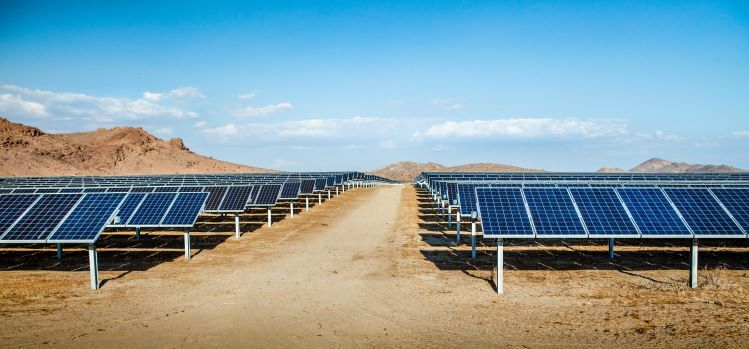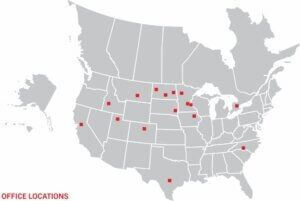Bringing it All Together: Wind, Solar and Battery Storage in Northwest Ohio to Power General Motors

October 28, 2021
Haviland, Ohio – Paulding County, in northwest Ohio, has some of the flattest land in the state. Its soil is dark, rich and among the best in Ohio for farming. And it’s here, near the small town of Haviland, that in 2009 a group of farmers saw the potential of wind power.
Ulteig was the substation design engineer when, in September 2018, the Northwest Ohio Wind project—a 105-megawatt (MW) wind energy farm located on 10,000 acres and comprised of 42 wind turbines, each generating 2.5 MW of wind energy—started reliable commercial operations. After studying the opportunity, NWO Wind, LLC (owner, a CMS company) re-commissioned Ulteig to design and engineer the addition of a solar PV array and battery energy storage system (BESS) to form the nation’s third utility-scale renewable hybrid project.
“We viewed hiring Ulteig to be a ‘building success on success,’ especially when many on the wind substation team, led by Ulteig’s TJ Severance, technical manager, and Kap Phanthavong, project management supervisor, were made available to us,” said Chuck Hookham, PE and Executive Director of Project Management with CMS Enterprises.
Hookham added how proud he was of all the project participants, including Ulteig, for achieving a commercial operation date in less than 16 months and with zero safety incidences or illnesses, despite challenges including COVID-19 and fast-track approvals.
In 2018, CMS Enterprises acquired the Northwest Ohio Wind project from subsidiaries of Starwood Energy Group Global, with a 15-year renewable energy purchase agreement with General Motors that now encompasses all renewable energy from the hybrid project.
Northwest Ohio Wind is one of just a few utility-scale wind projects developed, permitted and installed in Ohio, producing about 320,000 megawatt hours (MWh) of renewable energy per year—enough to power approximately 30,000 Ohio homes. Northwest Ohio Wind helps offset carbon emissions from seven Midwest-based General Motors plants. The carbon offset is equivalent to planting more than 6.1 million trees.
Building on the success of Northwest Ohio Wind, CMS commissioned Ulteig to design and engineer the addition of a solar park and battery energy storage system.
With rotors measuring 116 meters in diameter installed on 90-meter towers, the facility’s wind turbines are engineered for efficient energy production. The power generated flows from the wind turbines into American Electric Power’s Haviland Substation.
Design and Engineering
The intent of adding solar power and a battery energy storage system to Northwest Ohio Wind is reliability and diversity. Capturing the sun’s energy when the sun shines and storing that energy for a given period allows CMS to create a more self-sufficient and reliable energy plant for its primary customer. Adding these new components, CMS further limits the need to pull energy off the grid—energy they would need to pay for—during periods of low production to meet customer needs. This addition allows CMS to offset those costs, and under low wind cases, even allows the solar and battery energy storage system to output additional power to the grid.
“This could be the future for many wind farms,” said T.J. Severance, Ulteig technical manager. “It’s a unique project where solar and battery storage will bring additional reliability to new and existing projects. I think we’ll see a lot more of these types of projects in the future.”
Built on roughly 30 acres, the solar park is comprised of up to 3.5 MWdc solar PV modules connected to an AC “central” inverter. The inverter(s) output to an adjacent/integrated step-up transformer to bring the system to 34.5 kV and will be terminated to the substation via a single underground AC circuit.
The new Battery Energy Storage System (BESS) is a 1 MW by 3.4 MWh facility feeding the central inverter via DC coupling. The BESS facility consists of short-duration (up to 8 hours) lithium-ion batteries housed inside prefabricated enclosures/containers, power conversion systems and an auxiliary power electrical equipment racking system. It will utilize concrete pier foundations.
The solar and storage generation will tie into the existing Northwest Ohio Wind substation at 34.5 kV through a step-up transformer and new feeder addition at the substation.
To complete the construction of the approximately 30-acre project site, the civil engineering design included new access roads, perimeter fencing, erosion control and site grading to improve the drainage on-site and meet the specifications needed for racking and pile installation. In addition to site grading, the civil design included an expansion to the existing substation to account for the addition of new equipment. The design had to accommodate for all aspects of the existing conditions and use them in the proposed design.
For this project, Ulteig teamed with one of its specialty engineering partners, Ontario-based NLS Engineering* to design the energy management system (EMS). This partnership provided a control system design for the solar and storage addition, which could integrate with the controls for the existing Northwest Ohio Wind site to enable prudent forecasting of wind, solar PV and solar-charged battery dispatch and to make smart battery charge/discharge decisions. While the solar farm and BESS will have their own customized EMS system, the EMS system will source some information from the wind farm to make decisions.

Building Understanding to Drive Efficiency and Effectiveness
To build a highly efficient and effective solar park and BESS, Ulteig conducted multiple studies at the existing site to build a better understanding of the overall system and effectiveness of the recommended equipment. These studies included:
- Load Flow/ Power Flow/ Reactive Compensation Study
- IEEE Effectively Grounded Study
- Arc Flash Risk Assessment
- Short Circuit Study
- Power and Energy Loss Study
- Cable Ampacity Study
- Insulation Coordination Study
- System Protection Coordination Study
“The cumulative effect of these studies helped us build a strong understanding that informed our design process,” said Severance. “In addition, we also could draw on our experiences doing similar projects like Permian Solar in Texas, Mustang Solar in California and Lee Dekalb Solar in Illinois, where we added battery storage to an existing site.”
Bottom Line: Adding More Power to Wind
“While this was a small project,” Severance said, “its significance shouldn’t be understated. There are dozens of similar stand-alone wind farms throughout the U.S. whose potential could be boosted by adding solar and battery storage systems to their operations. These types of projects can provide more capacity, more reliability, more sustainability during low production periods and increase the production of power when it is needed most.”
Learn More About Ulteig’s Renewables + Energy Storage Expertise
The energy professionals at Ulteig can help you model an optimum standalone energy storage system or help design a new renewable plus storage project to help you minimize costs and maximize revenue. We leverage expertise across Lifeline Sectors and Solutions to provide a comprehensive project approach. Learn more, here.
*In May 2021, Ulteig acquired NLS Engineering, turning our long-standing partner into part of the Ulteig team.
WHAT MAKES ULTEIG DIFFERENT?
From global energy producers to locally funded cities and private developers to government agencies, the clients we serve encompass a broad range of relationships and projects. Find out why Ulteig is a leader in the engineering industry.
Contact Us

